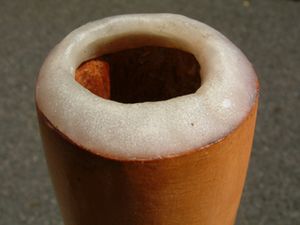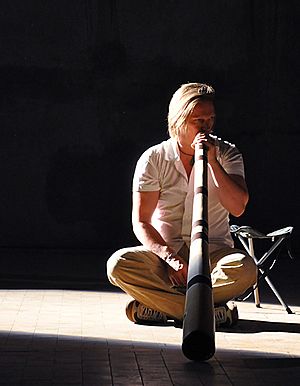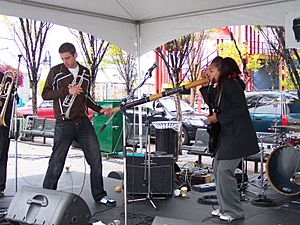Didgeridoo facts for kids

Australian didgeridoos
|
|
| Classification | Woodwind |
|---|---|
| Musicians | |
| Xavier Rudd, Charlie McMahon | |
The didgeridoo is an ancient Australian Aboriginal wind musical instrument. It was first used by the Yolgnu people in Arnhem Land. This area is in northern Australia.
Didgeridoos are long, hollow wooden tubes. They can be from 1 to 3 meters (3 to 10 feet) long. Most are about 1.2 meters (4 feet) long. A longer didgeridoo makes a lower sound. It is like a wooden trumpet or a drone instrument.
It is hard to know exactly when didgeridoos were first played. Old rock art in Arnhem Land shows them being used over 1,500 years ago. One painting shows a didgeridoo player with two singers. They are playing in a ceremony.
Contents
What Does "Didgeridoo" Mean?
The word "didgeridoo" was likely made up in the West. It is not an Aboriginal word. Some people think it comes from old Irish words. These words mean 'trumpeter' or 'hummer'. But this idea is not widely accepted.
The word first appeared in print in 1919. It was called an "infernal didjerry" in a newspaper. It was said to make a sound like "didjerry, didjerry."
Aboriginal people have many names for this instrument. There are over 45 different names. One common name is Yirdaki. This name is used by the Yolngu people in north-east Arnhem Land.
How a Didgeridoo is Made
Traditional didgeridoos are made in Northern Australia. They are usually made from hardwood trees, like eucalyptus. Sometimes, native bamboo or pandanus is used. Makers look for trees that have been naturally hollowed out by termites. The size of the hollow inside is very important for the sound.
Once a suitable tree is found, the hollow part is cut out. The bark is removed, and the outside is shaped. The didgeridoo might be painted with traditional designs. A rim of beeswax is often added to the mouthpiece end. This makes it more comfortable to play.
Didgeridoos can also be made from other materials. These include PVC pipes, fiberglass, or metal. Modern didgeridoos can have different shapes and designs. They are seen as a separate type of instrument.
Playing the Didgeridoo
Didgeridoos are often played while sitting down because they are long. Players make a continuous sound by vibrating their lips. They use a special way of breathing called circular breathing. This means you breathe in through your nose while pushing air out of your mouth.
A skilled player can keep the sound going for a very long time. Some players can play for over 40 minutes without stopping. This special breathing creates the unique sound of the didgeridoo.
Players can also add vocal sounds to the drone. These sounds often copy Australian animals, like the dingo or kookaburra. By using their voice while blowing, players can make many different sounds. This makes the playing more complex and interesting.
Uses of the Didgeridoo
The didgeridoo was mainly played for ceremonial dancing and singing. It was also used for entertainment outside of ceremonies. In northern Australia, it is still very important for cultural ceremonies. Today, didgeridoos are played for entertainment all over the world.
Clapsticks, or bilma, are often used with the didgeridoo. They set the beat for the songs during ceremonies. The rhythms of the didgeridoo and clapsticks have been passed down for many generations.
Traditionally, only men played the didgeridoo in ceremonies. Both men and women could dance. While women did not play in ceremonies, there was no rule against them playing in informal settings.
Didgeridoo in Popular Culture
The didgeridoo is now used in many types of music. It can be heard in experimental music and even some metal bands. It helps create unique sounds and rhythms.
Souvenir Didgeridoos
Many didgeridoos made today are for tourists. These are often made from different types of wood. They might have colorful designs that are not traditional. These souvenir didgeridoos often cannot be played as real musical instruments.
Aboriginal communities sometimes find these souvenir items disrespectful. The designs might not be accurate or traditional. Copying traditional artwork to sell souvenirs can also be misleading to tourists.
Health Benefits
A study in 2005 found that playing the didgeridoo can help with snoring and sleep apnea. This is because learning circular breathing strengthens muscles in the throat. Stronger throat muscles help keep the airway open during sleep.
Images for kids
-
Didgeridoo and clapstick players performing at Nightcliff, Northern Territory
-
Ŋalkan Munuŋgurr performing with East Journey
See also
 In Spanish: Didyeridú para niños
In Spanish: Didyeridú para niños










